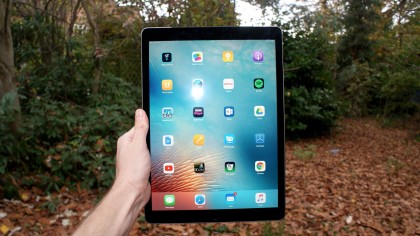Adobe says iPad Pro can't replace a laptop for creative work, and it's okay
iPad Pro versus Surface Pro 4 debate heats up
Because the Surface Pro runs Windows, it runs the full desktop version of Photoshop and the rest of the programs available in Adobe's Creative Cloud, Macy said, bringing 25 to 30 years of Adobe heritage.
"It's not practical to bring the Mac version of Photoshop [to the iPad Pro]," Macy added.
Developing Photoshop for the iPad
On iOS, Adobe took a different approach. Apps are more focused, and they don't have the full functionality of the version designed for the desktop operating system.
"So, what we've been doing instead is reimagining the functionality in our applications, and figuring out how we can strip down some of the 25 to 30 years of features and use cases into building blocks as individual applications, and how we can connect the apps back to our desktop [programs] so users can build a better workflow.

For Photoshop, Adobe unveiled three iOS apps that mimic three distinct use cases offered on the desktop app. Photoshop Fix, Photoshop Mix and Photoshop Sketch were introduced to replicate three different ways that users interacted with Photoshop on their PCs or laptops.
With Fix, Adobe brings some of the photo retouching tools from its desktop app to the mobile workflow, while Sketch brought in some of the drawing functionality when used with the Apple Pencil stylus. Photoshop Mix is used for compositing.

"We realize that creative professionals often need to create their own workflows by stitching together different features from different apps," Macy said. "So what we're doing with these apps is connecting them all together with a feature called Creative Sync."
Sign up to the TechRadar Pro newsletter to get all the top news, opinion, features and guidance your business needs to succeed!
Creative Sync allows people to work on a project across Adobe's suite of apps. For users on multiple devices, it also enables projects to synchronize between an iPad Pro and a desktop, and this brings added flexibility on which device to use for the type of creative work that needs to be done.
Working with the limitations
"One of the creative limitations on iOS for years was the camera roll," Macy said. Creative professionals would work with images and files, and the common denominator for sharing the finished product is the camera roll, but iOS would only recognize JPEG and PNG files.
This means that layers and editable elements within a project file would be lost once the final product is exported for sharing with the camera roll.
To overcome this OS-level limitation, Adobe introduced Creative Cloud so creatives could save their work to the cloud and have access to them in other apps on iOS as well as on the desktop.